Some wrote their own vows. Others claimed the well worn lines for themselves. Some saw their marriage as a deeply personal promise. Some embraced it as a political act. Some had wed long before — exchanging vows, rings and kisses in churches, parks and backyards. Married in their hearts, if not in the eyes of the government.
On Aug. 1, 2013, when the state’s marriage law became gender-neutral, gay, lesbian and nonbinary couples entered into an institution they’d long been denied, claiming its rights and complications.
Along the way, they made it their own.
Months after Minnesota voters rejected a constitutional ban on same-sex marriages — but years before the Supreme Court recognized them — the legislation spurred a flurry of much-publicized, post-midnight weddings and thousands of marriages since.
We’re looking back at 10 years of same-sex marriage in Minnesota by having conversations with 10 couples, nine of whom married — and in one case, divorced — over the decade. They delved into issues of equality, of diversity, of legacy. And, of course, of love. The interviews have been edited for length and clarity.
‘What we wanted for our son’
Jenny and Nicole Starr want to be known for the things they love. In Jenny’s case, that’s gardening, downhill skiing, Taylor Swift and the Minnesota State Fair. Nikki, meanwhile, loves books and bowling, K-pop and women’s basketball.
And each other.
The longtime couple are both judges: Jenny is a chief administrative law judge for the Office of Administrative Hearings and Nikki is a judge in Ramsey County District Court. both The pair met as undergrads at the University of Minnesota and dated while earning their law degrees. They first wed at their Unitarian church, in front of friends and family, in 2006. But when same-sex marriage passed, they were in the process of adopting their son, then 9 years old. So they wanted to make things legal as quickly as possible.
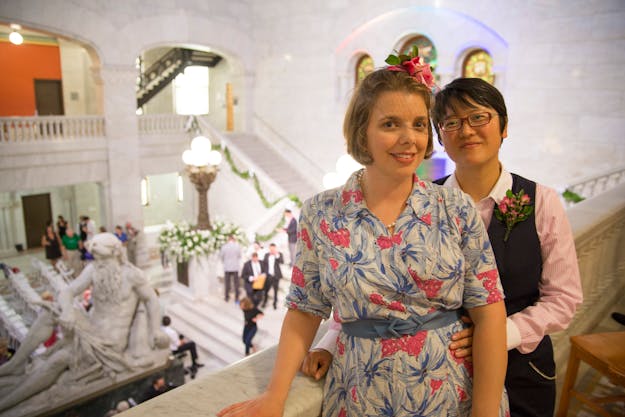
Jenny and Nicole Starr, of St. Paul, were among the couples who married after midnight at Minneapolis City Hall in 2013. Nicole described it as “this incredible moment where like, this is important, and we matter and our families matter.”
Jenny: “While our community marriage gave us love and support and recognition, legal marriage is what we wanted for our son.”
Nikki: “Had we not been able to get married, we would have been, in the adoption papers, basically strangers who were forming this family with this child. He had already come out of the foster care system and knew well systems that had really been unfair. So to start off with this non-truth? How do you explain that to a 9-year-old — that the paper says one thing, but it doesn’t mean what it says?”
Jenny: “So by getting married when we did, the final court decree was able to express that Jenny Ryan and Nicole Kubista, who petitioned for this adoption, have since married and now, as Jenny and Nicole Starr, are adopting their son. It means something. It meant a lot to our son.”
Nikki: “We really wanted to be able to say to him, ‘We all have the same name. We are a family. This family is safe, and it will never change.’ ”
Jenny: “We love Minnesota. We are products of Minnesota public education, we have given our careers and service to the public of Minnesota — specifically and intentionally. And that night, at 3 o’clock in the morning, 10 years ago, it felt like Minnesota was saying, ‘We love you, too.’ ”
‘Full of joy and love’
By the time Alex Schmit and Zeke Rice wed at Minneapolis City Hall during that burst of post-midnight marriages, they had been together for “14 years, 10 months and 21 days.”
Schmit: “Beforehand, there was a conference call with all the couples. They said, ‘We’ve never done this before. But don’t think of this as being a conveyor belt of love.’ ”
Rice: “Which we actually thought, ‘That sounds like it could be fun.’ ”
Schmit: “I want to be on a conveyor belt of love.”
Rice: “As each couple was married, that open lobby area of City Hall would just erupt in cheers.”
Schmit: “The entire atrium was decked out in flowers and there were, like, seven stories of people looking out. It sounds a little corny, but it was full of joy and love. At 3 in the morning, that helps you make it through the night. Because I’m usually in bed by 10.”
‘We belong there, too’
By the time Erin Sharkey and Zoe Hollomon met in Buffalo, N.Y., people assumed they knew one another, “just because there weren’t a ton of mixed girls in our age group,” Sharkey said. But in a way, they did. They were immediately inspired by one another’s activism, felt understood by one another’s mixed-race identities.
During their courtship, Sharkey’s mentor, Harlem-born writer and poet Alexis De Veaux, invited them to gatherings at her home. “It was wonderful to be welcomed into a community of other lesbians of color and queer folks,” Hollomon said. “To be like, ‘Wow, like, this is what queer love looks like when you’re Black and you’re older.’ ”
Now, 15 years into their own marriage, Sharkey and Hollomon have become those elders, hosting folks at their northeast Minneapolis home and their Annandale, Minn., retreat center.
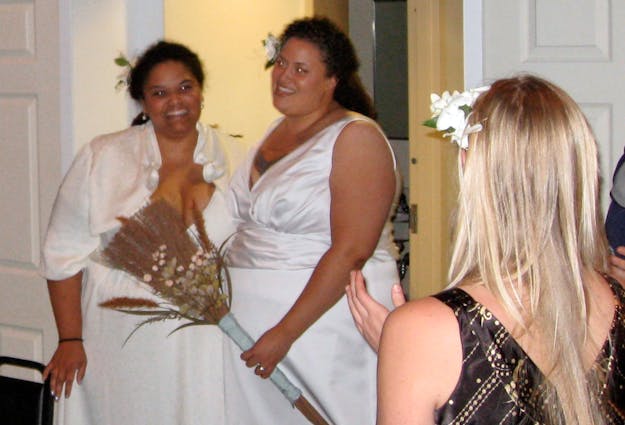
Erin Sharkey, left, and Zoe Hollomon married in October 2007 in Canada, holding a ceremony in Buffalo, N.Y., with help from friends and family. “We were broke kids ... but our crew came together," Sharkey said.
Sharkey: “We had heard that Canada was marrying queer people. And being in Buffalo, you can get to Niagara Falls in 20 minutes. So in the fall of 2007, our families came from New York City and Minnesota and all over the country.”
“I think marriage as an idea is a complex one. But we felt it was a political act. When it came to the question of: Are we going to do traditional vows or write our own? We really wrestled with it. I’m a writer, I’m a poet. Writing vows made sense to me. But I did feel like there was something subversive around saying the traditional vows. It felt like we were insisting. We were kicking it open and prying it open and saying that we belong there, too. And so we did both.”
“We were there in New York when gay marriage passed. And we went to the first official weddings in the middle of the night at Niagara Falls. They lit the falls up like a rainbow. Then we moved to Minnesota in 2012 — just in time to fight for marriage here.”
Hollomon: “With our community and our friends, it feels like we get to welcome newly-in-love queer people who want to be in a relationship that way. We help a lot of lesbian and queer people plan their weddings. We’ve been together for maybe 18 years. So we get seen as the elders or mentors that we had, just being an example of what love looks like.
“It also stands in the face of people who don’t want to acknowledge that any other kind of love other than heterosexual heteronormative love is valid or possible or long-lasting.”
‘A public announcement’
Single into her 40s, Jane Moldaschel prayed for someone to share her life with. Then Crista Stahl moved in next door. Over the years, they wore a path between their backyards in Windom, Minn., pop. 4,600. Stahl’s son cleared it each winter with a snowblower. Moldaschel, now 65, was a soon-to-be-retired teacher, and Stahl, 52, a letter carrier. They worried about how co-workers, friends and neighbors in their small conservative city would react to their love. So they kept it secret.
But when, 13 years into their relationship, same-sex marriage became legal, they sent out a save-the-date and held their breath.
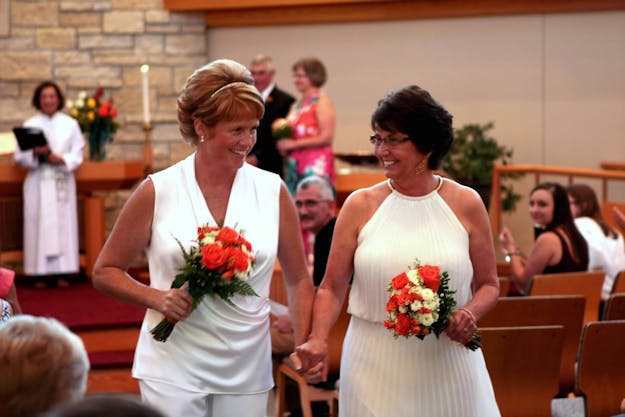
After quietly dating for 13 years, Crista Stahl, left, and Jane Moldaschel wed in 2013 at a church in Mankato. Moldaschel is a spiritual person who believes that “God truly put Crista in my life.”
Moldaschel: “We knew it would be a public announcement of who we were and who we loved. You were scared that on your mail route people were going to give you grief.”
Stahl: “Because I was out there all by myself! But the reaction has been totally opposite of what we thought. One guy on my route — I was a little scared of him — came out and said, ‘Hey, I heard you’re getting married!’ And I was quietly like, ‘Yeah.’ And he said, ‘My son just got married, and now I have a son-in-law.’
“He’s our biggest fan. He’s always asking about us.”
Moldaschel: “When same-sex marriage became legal in Minnesota, Crista and I were given the opportunity to publicly ask the people in our lives for their support. Just as importantly, our friends, family and people in our lives from conservative, small-town Minnesota were given the opportunity to offer us their support. For Crista and me, we couldn’t imagine so much love and support was possible.”
‘We have to do it again’
Ten months after meeting in 1993, theater artists Todd Hughes and Robert-Bruce Brake exchanged vows before friends and family at St. Paul’s Church on the Hill in St. Paul. “The ceremony nearly derailed the election of a new bishop of the diocese,” Hughes said. “We needed security and were forced to lock the doors.” On the same date 20 years later, the pair married in a legally binding ceremony — reciting the same vows, before the same guests, in the same church.
But this time, the doors were open.
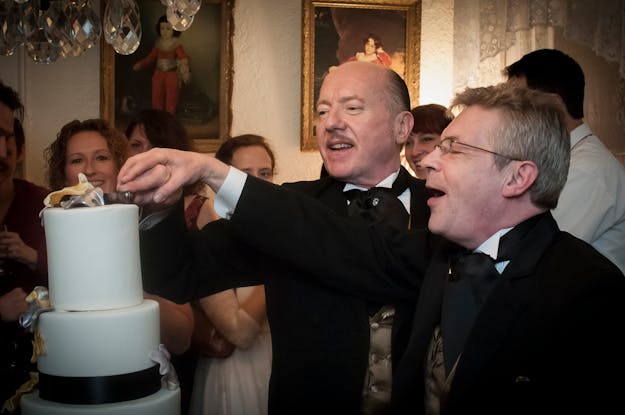
Robert-Bruce Brake, left, and Todd Hughes cut the cake after exchanging vows at St. Paul’s Church on the Hill in 2013. “Todd and I are both introverts,” Brake said. “So we’re not likely to go out and march. But I guess we saw marriage as our own form of protest.”
Brake: “The vicar at the parish said, ‘If we’re going to perform this ceremony, we’re going to do it right, so no one will ever question that this is serious relationship.’ So we had a solemn high mass with a chant choir. I mean, it was almost two hours long.”
Hughes: “Communion, homily, the whole nine yards.”
Brake: “Twenty years later, we were at the Capitol signing ceremony, and as soon as we saw Gov. Dayton sign it, I think we turned to each other and said, ‘We have to do it again.’ Luckily, we’d had a dress rehearsal.”
Hughes: “Prior to this law being passed, we had seen so many same-sex couples who had been together, who were committed to one another, who loved one another, but when one of them died, the family swooped in and kicked them out. I said, ‘I don’t want that to happen to us.’ ”
Brake: “We want the same, normal rights that everyone else has. And maybe if we had those, we wouldn’t be looked upon as different.”
‘Staking out the territory’
When Lisa Vecoli and Marjean Hoeft began dating in 1984, they didn’t dream of marriage. They were feminists who saw marriage as a product of the patriarchy. But when efforts arose across the country to ban same-sex unions, the right became more important. “It was more about staking out the territory,” Vecoli said. When Minnesota made same-sex marriage legal, they considered tying the knot on their dating anniversary in December.
“And I said, ‘We’ve been waiting 28 years.’” Vecoli said. “‘I’ll be damned if I’m waiting another six months.’ ”
So on Aug. 1, wearing white blouses, they wed along the river near their house.
Vecoli: “We had 200 people, plus or minus, at our reception. Sometimes when you go to a wedding, there’s somebody who set the couple up and they’re like, ‘I did that.’ At our wedding, everybody felt that way. Because everybody had voted and everybody had volunteered and everybody had posted a lawn sign and everybody had given money and everybody had been fighting for our right to get married. So everybody felt a sense of ownership and possession of our ability to get married.”
Hoeft: “That made it such a celebration.”
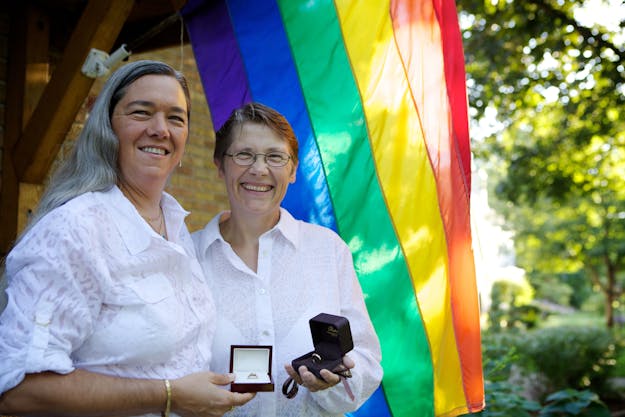
Lisa Vecoli and Marjean Hoeft married on Aug. 1, 2013. It didn’t change things inside their relationship, Vecoli said. “But the world around us felt changed.” A constant level of anxiety – around legal, medical and other systems – suddenly eased.
‘Married at heart’
From the start, it was clear that Betty and Lynn Fishbein connected deeply, soulfully. “There were a lot of times when we would just look into each other’s eyes and start laughing, without a word,” Betty said.
They married at their synagogue in 1999 with a rabbi, vows and a ketubah — “everything but the legal paper,” as Betty put it. “We considered ourselves married at heart from then on out.”
Then, in 2008, Lynn got a headache that led to an MRI, which found a rare form of brain cancer. After chemo, she was declared cancer-free, “and the next couple years were just fabulous,” Betty said. But the cancer returned. The couple watched footage of those first weddings in 2013 from a hospital room.
Betty: “The hospice chaplain asked, ‘Had you guys ever thought about getting married?’ ‘We’ve not only thought about getting married — we did get married.’ The chaplain asked, ‘Are you going to now?’ An hour later, the chaplain came back with all the paperwork. The judge across the street authorized a waiver. ‘You can get married here tomorrow.’
“The only thing that I remember about that whole thing, honestly, were the words, ‘until death do you part.’ ”
“It was very, very bittersweet, to finally have that benefit, to have it be acknowledged by the state of Minnesota. We got to enjoy that for a three-month period. [Lynn died in November 2013 at age 51.] She would keep forgetting: ‘Did you know that gay and lesbian people can get married?’ And I would say, ‘Lynn, we’re married.’ Then I would jump on her and hug her and kiss her. She’d go, ‘Oh my gosh!’ She couldn’t believe it, you know.”
‘Good or bad’
During the Pride parade in 2013, Kelly Frankenberg wore a cartoon-like speech bubble on her pregnant belly: “Thanks to Minnesota, my moms will be legally married!” A month later, that belly clad in a white dress, Frankenberg and Donna Nguyen were among the first couples to wed.
They divorced in 2017 and co-parent their now 9-year-old son. Nguyen has since remarried.
Nguyen: “Our child Jace (we call him Bear) is a mix of our genes. Getting married simplified things and provided clarity in the important legal aspects of being parents together.”
Frankenberg: “It felt like good family security. Because then, her name was able to be on the birth certificate. When we got divorced, she was the other legal parent. She didn’t have to adopt him separately and go through all these court battles.”
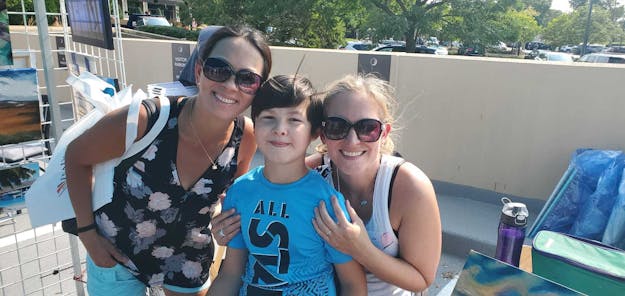
Donna Nguyen, left, and Kelly Frankenberg with their son, Jace, whom they call Bear. Frankenberg was pregnant when the two married at Minneapolis City Hall in 2013.
Nguyen: “When Kelly and I got divorced, I initially lost faith in the concept of marriage. I was guarded. I spent time healing and took things slowly until I met my current wife, Rachel.”
Rachel Petersen-Nguyen: “Getting to share this genuine love with Donna, in a way that is recognized legally by Minnesota, is something I would have never dreamed was possible. When marriage was legalized for all people in Minnesota 10 years ago, it made it possible for me to become my authentic self, sharing this important part of who I am inside on the outside.”
Frankenberg: “A divorced writer once told me, ‘Everyone should be able to get married once in order to know why not to.’ Everyone deserves that right to get married and everything that comes with it — good or bad.”
‘All those worries dissipated’
Nic and Lisa Zapko met onstage. Nic was an actor with the Northern Sign Deaf Theater, using American Sign Language. Lisa, an interpreting student at St. Catherine University, “was my voice,” Nic said. When Nic went on tour, the two kept in touch via fax. They danced at First Avenue. People would ask, “What’s going on with the two of you?”
“We’re friends,” Lisa would answer.
And they were. Until one day, when they hugged. Then Lisa knew: “Nic must be involved in my life now forever.”
The couple held a commitment ceremony in 2001. By the time same-sex marriage passed in Minnesota, they had two children.
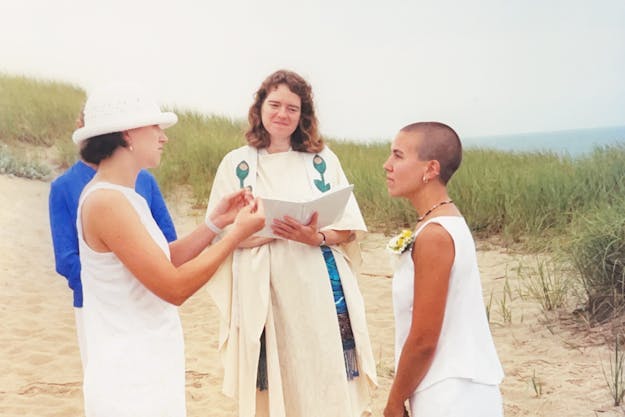
Lisa and Nic Zapko held a commitment ceremony 2001 in Provincetown, Mass., an anniversary they still celebrate. When same-sex marriage became legal in Minnesota, “it was a pinch-me moment,” Nic said.
Nic: “Because we did have kids prior to our legal marriage, we had to go through lawyers and make sure that I also had rights to be involved. So I adopted them. What if something happens to Lisa in the hospital? There are rights for while she was pregnant, rights for after, it was very complicated. And it really kind of affected me — it was pretty stressful.
“Then when same-sex marriage became legal, that pressure for all these things, all those worries, kind of dissipated. These are our children. This is our family. I have a right to be involved.”
‘I want to keep growing’
When marriage equality passed, Jason Jackson and Jason Bucklin had been dating for six months. A beautiful six months, for sure, but mostly, their thought was: “Don’t get any ideas,” as Bucklin put it. At that point, neither saw marriage as a model. And while the state was focused on marriage, Jackson and Bucklin were both working with LGBTQ youth, grappling with issues that felt more pressing — including housing, HIV/AIDS and mental health.
“Many people, myself included, were looking at the world from life or death versus access to tax breaks or double incomes,” said Jackson.
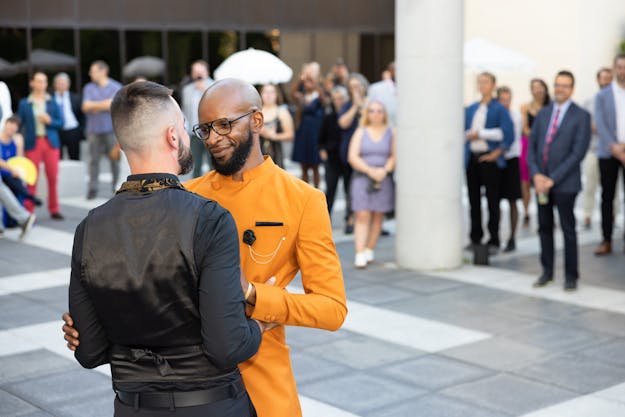
Jason Bucklin, left, and Jason Jackson wed last year at the Minneapolis Institute of Art. Bucklin proposed after the pair built a garden box together. “I just remember having this feeling: I want to keep building things with him. I want to keep growing things with him.”
Jackson: “When I was a little boy, I used to think, ‘OK, I will marry a nice woman and live in a house and have two kids.’ Then when you realize that who you are is who you are, you have to mourn not only the expectations that your family has but the whole story. So marriage was no longer for me, right? I had to mourn that and let it go.”
Bucklin: “I didn’t grow up with marriage as a goal or a framework for what a successful relationship looks like. And part of queerness to me was like making it your own and defining things your own way.”
Jackson: “It wasn’t until the pandemic, when we were seeing so many people dying around the world, that I thought, ‘What if something happens to this person who I’ve built my life with for 10 years?’ I trust his parents, you trust mine, but who knows. And I had this flashback to the ’80s, right? Where somebody would die and the mother would come in and take everything. I wanted to make sure that what’s mine is his if, God forbid, something happens to me or vice versa. So that’s where for me, marriage — and how we build our systems — became really, really important.”
Bucklin: Marriage was the conversation that brought people who aren’t in the community to start talking about supporting LGBTQ people. It got people to the table. Now that it’s 10 years in — we’ll call it the honeymoon phase — we’re in a place where we’re starting to get a really strong, vitriolic pushback on issues. For folks who came to the table in 2012 during marriage, it had been a rosy time for LGBTQ rights. They hadn’t seen what it’s like when we’re under attack, and might not actually be prepared to step up in the ways that we need now that we’re under attack again.
“Now that pressure’s increasing, it’s time to recommit — time to renew your vows. Because it’s not enough to just end at marriage.”
Credits
Writing and Reporting Jenna Ross
Photography Jeff Wheeler
Videography Matt Gilmer, Jeff Wheeler
Editing Connie Nelson, Sue Campbell, Bill Hammond
Design and Development Anna Boone, Madalyne Bird, Jamie Hutt